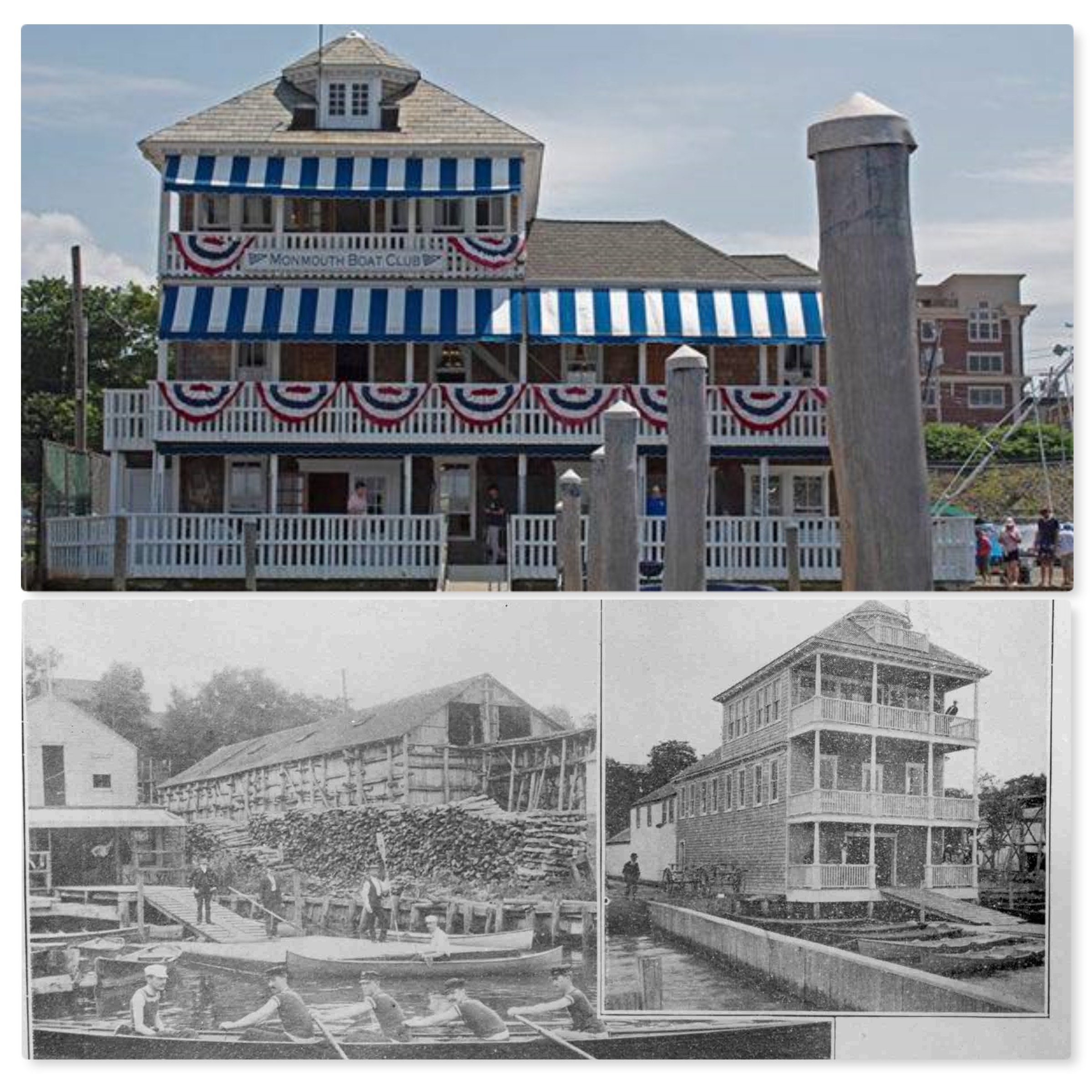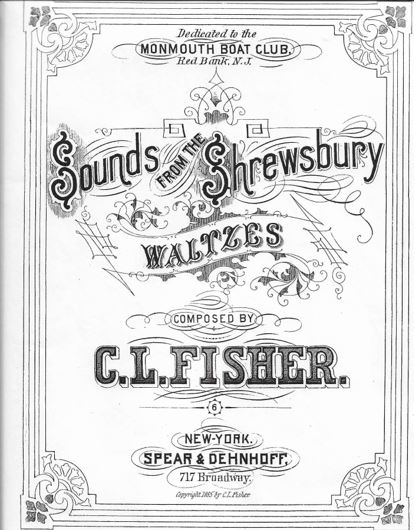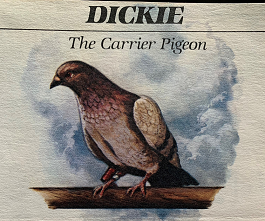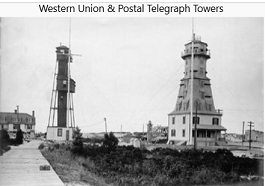
DID YOU KNOW... the MBC clubhouse has been rebuilt multiple times?
(Top Photo) The clubhouse today. The right half of the building was an addition, completed in 1930, to the 1895 clubhouse.
(Bottom Left Photo) A four-oared barge with coxswain and single Ruston-type canoe pose in front of the original clubhouse, which was built in 1880. The firewood and shed at the right of the house are part of John A. Worthley’s coal and wood yard.
(Bottom Right Photo) When the new Monmouth Boat Club clubhouse was built in the summer of 1895, the lagoon in front of the old club was bulkheaded and filled, piling was driven and the new 25x50 foot building constructed on it. The old building was then moved 35 feet closer to the river and attached to the back of the new and ground floor was opened through. All of the work cost ‘nearly $4000. This is considerably more than it was intended at the first expend…’ commented the Red Bank Register. The new building was built by Charter Member Archibald Antonides.
DID YOU KNOW… In 1885 a composition of 6 waltzes by C.L. Fisher was dedicated to our club? |
Sheet music entitled Sounds from the Shrewsbury “Dedicated to the Monmouth Boat Club Red Bank, N.J.” was composed by C.L. Fisher and published by Spear & Dehnhoff, 717 Broadway, New York in 1885. This work is on file in the Library of Congress and is part of the musical collections entitled: Music for the Nation: American Sheet Music, Ca. 1870 to 1885; The Library of Congress Celebrates the Songs of America. Little is known by this writer about the composer C.L. Fisher and why MBC and the Shrewsbury were the inspiration for his waltzes. Was he a member? Did Fisher travel to Red Bank on holiday or to enjoy the festivities of the winter carnivals? We have photographic proof participants of the Winter Carnivals danced on the frozen river. Perhaps we have a reader and historical sleuth who’d like to solve some of the mystery surrounding this treasure. (Click here or on the score sheet to see the full composition in .pdf)
In the meantime, have a listen to an excerpt of the 10 minute presentation of waltzes.
Or sit back and enjoy the full score of waltzes and imagine yourself taking a spin on the dance floor. My thanks to my daughter Jossalyn, and her family for recording this piece and especial thanks to Jubilee’s piano instructor who brought to life this difficult musical gem after over a century of silence. |
In 1850 Dickie, the carrier pigeon, was commissioned to assist Captain Farrell at Western Union’s 70 foot observation tower in Sandy Hook. Captain Farrell scanned the ocean for inbound transatlantic ships. Once identified by code signals, he’d telegraph the Maritime Association in Manhattan to expect a specific ship. Now began Dickie’s job. The bird was taken by small boat to meet the ship where the latest news bulletins from Europe were waiting. The news was tied to the pigeon’s leg and Dickie flew back to the tower. There the news would was relayed by telegraph to New York and the nation. Well... maybe... Dickie was quite an "unique and independent little fellow." Sometimes Dickie decided to antagonize poor Captain Farrell by Dickie’s reign of torment for poor Captain Farrell and the rest of the nation ended around 1858 when he was declared surplus once the new transatlantic telegraph cable became operational. |
DID YOU KNOW... the river we know as the Navesink has had several names over its life? North Shrewsbury or Navesink or Navisink or Nave Sinck? The Navesink, or Navisink, (or Nave Sinck) were a group of Lenape Native Americans who inhabited the Raritan Bayshore near Sandy Hook and and the Rumson Peninsula in eastern New Jersey. Their territory included the highlands south of the peninsula, where they lived along its cliffs and creeks. Early settlers referred to the body of water by the original inhabitants' name, perhaps to distinguish it from the river to the south. But soon it became known as the Shrewsbury River. The North Shrewsbury River includes the Swimming River tidal estuary, which flows into the Navesink just north of Red Bank continuing ENE to Rumson joining the Shrewsbury River traveling to Sandy Hook Bay. Take a look at the maps below to see how the name changes. In 1781 John Hills, Surveyor and Engineer in the service of King George III sent this map to Sir Henry Clinton, General and Commander of the British Troops in America and identifies the river as the North or Navisink Harbour. The 1861 map refers to our home waters as THE Shrewsbury River with the estuary to the south as the South Shrewsbury River. In 1892, the Division of Geographic Names, part of the United States Geological Survey, made a formal decision that the official name of the northern tidal estuary is Navesink River, and specifies that it is “Not Neversink River nor North Shrewsbury River.” This decision was upheld again in 1935. Maps left to right: Mon.County 1781; 1781 name closeup; Mon.County 1851; 1851 name closeup; Mon.County 1861; 1861 name closeup |
DID YOU KNOW... a yacht that once served U.S. Presidents is cruising the Two Rivers today? Read about The Admiral's Barge on the Asbury Park Press site. Our thanks to MBC Member Joe Ruffini for actively preserving and sharing history with us. |
DID YOU KNOW...that "Winter Carnivals" were once popular events in Red Bank? |
The River in Winter For more than 100 years the Navesink has been the venue for winter entertainment and invention. Look back at chilly yet bustling activities with MBC in the center of it all. |
See transportation of all shapes and sizes used for sport, entertainment and commerce. Resources: MBC Archives and the book "Up and Down the River" by June Methot |


 DID YOU KNOW... New Jersey had its very own Telegraph Carrier Pigeon named DICKIE?
DID YOU KNOW... New Jersey had its very own Telegraph Carrier Pigeon named DICKIE? strutting just out of arm’s reach around the tower ledge. Teasing the Captain mercilessly as only a Jersey pigeon could do. “And so, it happened.” Scribner’s Magazine concluded, “that all of America, yearning for news of the Old World, waited on the caprice <whim> of Dickie, the carrier pigeon.”
strutting just out of arm’s reach around the tower ledge. Teasing the Captain mercilessly as only a Jersey pigeon could do. “And so, it happened.” Scribner’s Magazine concluded, “that all of America, yearning for news of the Old World, waited on the caprice <whim> of Dickie, the carrier pigeon.”